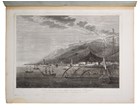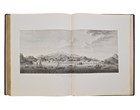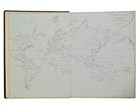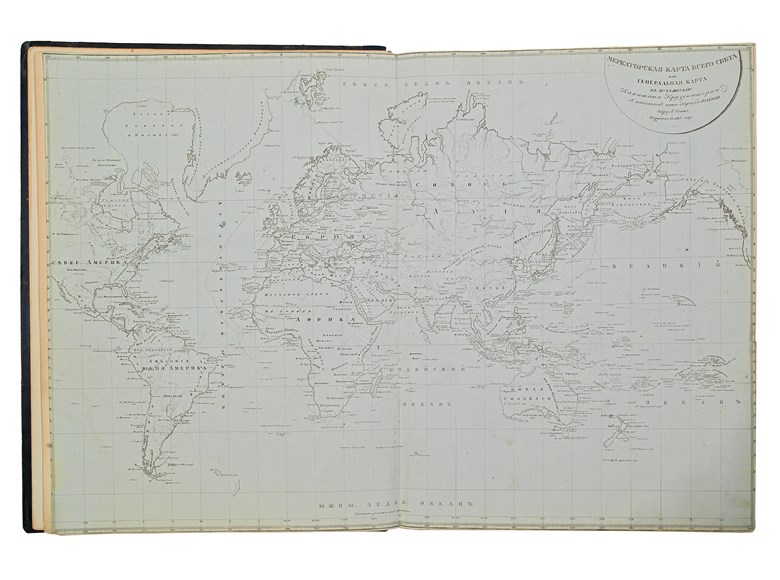 BACK TO GALLERY
BACK TO GALLERY
Daniel Crouch Rare Books
Ivan Fedorovich KRUZENSHTERN
Reise um die Welt.
The first Russian circumnavigation and one of the best examples of Russian printing and engraving.
Atlas: 603 by 465mm. Quarto volumes: 254 by 210 mm.
description
The rare first edition, German version, of the first Russian circumnavigation of the globe, published simultaneously in Russian.
Kruzenshtern’s atlas is an outstanding accomplishment of Russian cartography and travel illustration, and "one of the best – one may say magnificent – examples of Russian printing and engraving of the nineteenth century" (Lada-Mocarski).
Here the atlas is in the earliest variant known for this issue: the world map is dated 1813 (rather than 1815 or 1818), and all the maps and coastal profiles have captions in Russian only. Nearly all the maps in this copy are printed on thick, bluish paper. RBH and ABPC record no copy of the atlas having ever been offered at auction.
Kruzenshtern’s voyage is one of the most important after Cook, and is especially valuable for its description of the Northwest coast of America and of the North Pacific.
The expedition greatly improved cartographic knowledge but had much grander objectives: Kruzenshtern envisioned that, while exploiting this region’s resources – mainly fur – and trading these with China, Russia would develop its own, home-grown navy and finally shed its troubling dependence on Britain for personnel and training.
This ambitious expedition also set out to examine the viability of colonizing California, aimed to improve trade in South America, and to open relations with Japan and the Sandwich Islands. As Hill reports: “appointed to command the first Russian round-the-world expedition, had serving with him a brilliant corps of officers, including Lisiansky, Langsdorff, and Kotzebue. The expedition was to attempt to ‘open relations with Nippon and the Sandwich Islands, to facilitate trade in South America, to examine California for a possible colony, and make a thorough study and report of the Northwest coast, its trade and its future.’...The importance of this work is due to its being the official account of the first Russian expedition to circumnavigate the globe, and the discoveries and rectifications of charts that were made, especially in the North Pacific and on the northwest coast of America....The introduction is particularly important and interesting because of the information it contains respecting the state of Russian commerce during the eighteenth century, the Russian voyages and discoveries in the Northern Ocean, and the Russian fur trade”.
Kruzenshtern served with the English Navy against the French, as a Russian volunteer, in the revolutionary war of 1793-1799. During that time, he observed how important trade between England, the East Indies and China was; and how fortunes were being made by fur skins to China from the Northwest coast of America, where Russia had its own colonies, and began to anticipate a time when Russia could participate at the same level. In 1784, Grigory Shelikhov (1747-1795) had established Russia's first permanent North American settlement, the Three Saints Bay Colony, on Kodiak Island in Alaska. The Russian-American Company was established in 1801, and rapidly began asserting a monopoly over Alaskan trade, which it didn’t relinquish until Alaska was sold to the United States in 1867. Shelikov’s daughter, Anna, had been married to Nikolai Resanov, who vigorously promoted the project of Russian colonization of Alaska and California, and accompanied Kruzenshtern on his voyage.
Kruzenshtern, in command of two vessels, the ‘Nadeshda’ and ‘Newa’, sailed from Kronstadt, the main seaport of St. Petersburg, where the Tsar came to wave them off, and sailed west to Copenhagen, then Falmouth, crossing the Atlantic Ocean and stopping only once at Teneriffe, before reaching Santa Cruz in Brazil. During the winter of 1803-1804, they made their way to the Marquesas Islands via Santa Catharina Island and Cape Horn. Kruzenshtern then headed for Hawaii, perfectly located to serve as a refueling station for ships sailing north to China or the northwest coast of America.
The expedition separated once it reached Hawaii: Lisianskii sailed to the Northwest coast aboard the Neva, and Kruzenshtern continued to Japan – a journey that required considerable diplomatic sensitivity at a time when Japan was still a closed country. From there he sailed to Macao and Canton, where he was joined again by the ‘Newa’. Meanwhile, Lisiankii had sailed from Hawaii before heading on to Kodiak Island in southwestern Alaska. In August 1805, he crossed to the Russian settlement at Sitka, in southeastern Alaska, then crossed back to Kodiak to spend the winter and the spring of 1805. In September he returned to Europe. Lisianskii published his own account of the voyage in 1812.
The Greene copy and the Library of Congress copy appear to be the only two in the U.S. with this maximum number of plates.
Kruzenshtern’s atlas is an outstanding accomplishment of Russian cartography and travel illustration, and "one of the best – one may say magnificent – examples of Russian printing and engraving of the nineteenth century" (Lada-Mocarski).
Here the atlas is in the earliest variant known for this issue: the world map is dated 1813 (rather than 1815 or 1818), and all the maps and coastal profiles have captions in Russian only. Nearly all the maps in this copy are printed on thick, bluish paper. RBH and ABPC record no copy of the atlas having ever been offered at auction.
Kruzenshtern’s voyage is one of the most important after Cook, and is especially valuable for its description of the Northwest coast of America and of the North Pacific.
The expedition greatly improved cartographic knowledge but had much grander objectives: Kruzenshtern envisioned that, while exploiting this region’s resources – mainly fur – and trading these with China, Russia would develop its own, home-grown navy and finally shed its troubling dependence on Britain for personnel and training.
This ambitious expedition also set out to examine the viability of colonizing California, aimed to improve trade in South America, and to open relations with Japan and the Sandwich Islands. As Hill reports: “appointed to command the first Russian round-the-world expedition, had serving with him a brilliant corps of officers, including Lisiansky, Langsdorff, and Kotzebue. The expedition was to attempt to ‘open relations with Nippon and the Sandwich Islands, to facilitate trade in South America, to examine California for a possible colony, and make a thorough study and report of the Northwest coast, its trade and its future.’...The importance of this work is due to its being the official account of the first Russian expedition to circumnavigate the globe, and the discoveries and rectifications of charts that were made, especially in the North Pacific and on the northwest coast of America....The introduction is particularly important and interesting because of the information it contains respecting the state of Russian commerce during the eighteenth century, the Russian voyages and discoveries in the Northern Ocean, and the Russian fur trade”.
Kruzenshtern served with the English Navy against the French, as a Russian volunteer, in the revolutionary war of 1793-1799. During that time, he observed how important trade between England, the East Indies and China was; and how fortunes were being made by fur skins to China from the Northwest coast of America, where Russia had its own colonies, and began to anticipate a time when Russia could participate at the same level. In 1784, Grigory Shelikhov (1747-1795) had established Russia's first permanent North American settlement, the Three Saints Bay Colony, on Kodiak Island in Alaska. The Russian-American Company was established in 1801, and rapidly began asserting a monopoly over Alaskan trade, which it didn’t relinquish until Alaska was sold to the United States in 1867. Shelikov’s daughter, Anna, had been married to Nikolai Resanov, who vigorously promoted the project of Russian colonization of Alaska and California, and accompanied Kruzenshtern on his voyage.
Kruzenshtern, in command of two vessels, the ‘Nadeshda’ and ‘Newa’, sailed from Kronstadt, the main seaport of St. Petersburg, where the Tsar came to wave them off, and sailed west to Copenhagen, then Falmouth, crossing the Atlantic Ocean and stopping only once at Teneriffe, before reaching Santa Cruz in Brazil. During the winter of 1803-1804, they made their way to the Marquesas Islands via Santa Catharina Island and Cape Horn. Kruzenshtern then headed for Hawaii, perfectly located to serve as a refueling station for ships sailing north to China or the northwest coast of America.
The expedition separated once it reached Hawaii: Lisianskii sailed to the Northwest coast aboard the Neva, and Kruzenshtern continued to Japan – a journey that required considerable diplomatic sensitivity at a time when Japan was still a closed country. From there he sailed to Macao and Canton, where he was joined again by the ‘Newa’. Meanwhile, Lisiankii had sailed from Hawaii before heading on to Kodiak Island in southwestern Alaska. In August 1805, he crossed to the Russian settlement at Sitka, in southeastern Alaska, then crossed back to Kodiak to spend the winter and the spring of 1805. In September he returned to Europe. Lisianskii published his own account of the voyage in 1812.
The Greene copy and the Library of Congress copy appear to be the only two in the U.S. with this maximum number of plates.


















 SEND AN EMAIL
SEND AN EMAIL
 (212) 602 1779
(212) 602 1779